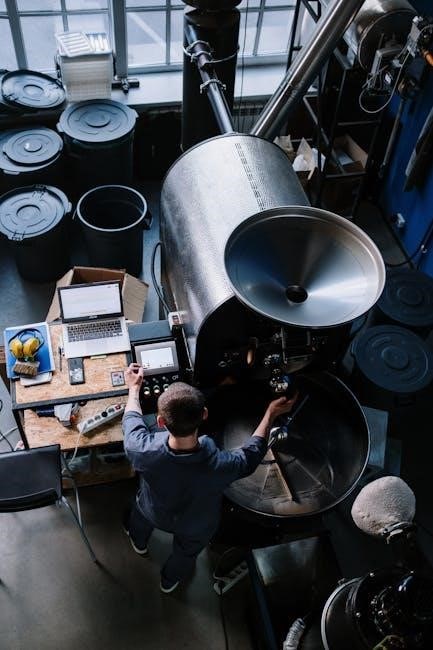The ANSI Z358.1 standard establishes requirements for emergency eyewash and shower equipment to ensure worker safety in hazardous environments. It was developed to address the need for consistent protocols in workplaces exposed to chemicals and harmful substances, providing guidelines for equipment installation, maintenance, and usage. The standard is widely recognized as a critical component of workplace safety programs, ensuring timely and effective emergency response to prevent injuries and long-term health consequences.
1.1 Overview of the Standard
The ANSI Z358.1 standard provides detailed guidelines for emergency eyewash and shower equipment, ensuring proper installation, maintenance, and operation. It specifies requirements for equipment types, such as eyewash stations, showers, and drench hoses, to protect workers from chemical and hazardous material exposure. The standard emphasizes regular testing and maintenance to guarantee functionality in emergencies, making it a cornerstone of workplace safety in industries handling hazardous substances.
1.2 Importance of Workplace Safety
Workplace safety is crucial for preventing injuries and ensuring the well-being of employees. The ANSI Z358.1 standard plays a vital role by providing guidelines for emergency equipment, reducing the risk of severe injuries from chemical exposure. Compliance with the standard not only protects workers but also helps employers avoid legal penalties and fosters a safer, more productive work environment. Adhering to these standards is essential for maintaining a safe workplace culture.
Historical Background of the ANSI Z358.1 Standard
The ANSI Z358.1 standard originated from the 1970 Occupational Safety and Health Act (OSHA), which mandated safer workplaces. It evolved to address growing concerns about chemical exposure and the need for standardized emergency equipment, leading to the development of specific guidelines for eyewash and shower stations to protect workers in hazardous environments.
2.1 The 1970 Occupational Safety and Health Act (OSHA)
The 1970 Occupational Safety and Health Act (OSHA) laid the groundwork for modern workplace safety standards. It mandated employers to provide safe working conditions, prompting the development of regulations for emergency eyewash and shower equipment. OSHA’s focus on preventing occupational injuries and illnesses led to the creation of standardized protocols, which ultimately influenced the formation of the ANSI Z358.1 standard to ensure effective emergency response systems in hazardous environments.
2.2 Evolution of Emergency Eyewash and Shower Regulations
The ANSI Z358.1 standard has evolved significantly since its inception, with key updates in 2004 and 2014. These revisions introduced stricter requirements for equipment performance, testing protocols, and installation guidelines. The 2004 update emphasized weekly activation of eyewash and shower units, while the 2014 revision enhanced testing protocols and clarified maintenance responsibilities. These changes reflect a continuous effort to improve workplace safety and adapt to emerging hazards in industrial environments.

Key Components of the ANSI Z358.1 Standard
The ANSI Z358.1 standard outlines specifications for emergency eyewash stations, showers, drench hoses, and combination units to protect workers from chemical exposure in hazardous environments.
3.1 Emergency Eyewash Stations

Emergency eyewash stations are critical for flushing chemicals or contaminants from the eyes. The ANSI Z358.1 standard requires eyewash stations to deliver a 15-minute continuous flush with potable water. They must be installed in areas with hazardous substances, ensuring accessibility within 10 seconds. Weekly activation is mandatory to ensure proper function, and annual inspections are required to maintain compliance and worker safety in industrial settings.
3.2 Emergency Showers
Emergency showers are designed to immediately flush contaminants from the body. The ANSI Z358.1 standard requires showers to provide a continuous water flow for at least 15 minutes. They must be easily accessible, visible, and unobstructed, with a showerhead height of 60-90 inches. Water temperature should be between 60°F and 95°F to prevent scalding or hypothermia. Weekly activation and annual inspections ensure proper function, aligning with workplace safety protocols and compliance requirements.
3.3 Drench Hoses
Drench hoses are supplementary emergency devices designed to provide a forceful water stream for rinsing contaminants from the body. The ANSI Z358.1 standard specifies that drench hoses must deliver a minimum flow rate of 20 gallons per minute. They should be easily accessible and positioned to allow quick use in emergencies. Regular testing is required to ensure proper function, aligning with workplace safety protocols and compliance standards.
3.4 Combination Units
Combination units integrate emergency eyewash stations and showers into a single system, offering comprehensive protection in hazardous environments. These units must meet ANSI Z358.1 flow rate requirements for both eyewash and shower components. They are ideal for spaces where multiple hazards exist, ensuring quick access to emergency flushing. Proper installation and maintenance are critical to ensure functionality, making them a practical solution for workplaces requiring efficient safety equipment.

Maintenance and Testing Requirements
The ANSI Z358.1 standard mandates weekly activation of emergency equipment and annual comprehensive evaluations to ensure proper functionality and workplace safety, preventing potential hazards and ensuring compliance.
4.1 Weekly Activation of Equipment
The ANSI Z358.1 standard requires weekly activation of emergency eyewash and shower equipment to ensure proper functionality. This routine check involves flushing units to clear debris and verify water flow. Weekly testing is crucial for maintaining readiness in case of emergencies. Employers must document these inspections to comply with regulations. Failure to adhere can result in OSHA fines, emphasizing the importance of strict adherence to maintenance schedules.
4.2 Annual Comprehensive Evaluation
The ANSI Z358.1 standard mandates an annual comprehensive evaluation of emergency eyewash and shower equipment. This detailed inspection ensures all components function correctly, including water temperature, flow rate, and spray patterns. The evaluation must be documented and performed by trained personnel. It complements weekly checks by addressing deeper maintenance needs, ensuring equipment reliability and effectiveness in emergencies. Non-compliance can lead to penalties, highlighting the importance of rigorous adherence to these standards.
Compliance and Regulations
The ANSI Z358.1 standard ensures workplace safety through regulated emergency equipment. OSHA enforces compliance, requiring proper installation, maintenance, and training. Adherence prevents violations and protects workers, reducing employer liability.
5.1 OSHA Regulations and Fines
OSHA enforces the ANSI Z358.1 standard, requiring employers to provide and maintain emergency eyewash and shower equipment. Non-compliance can result in significant fines, with penalties increasing by 80% in recent years. Failure to meet activation and maintenance requirements can lead to citations, emphasizing the importance of strict adherence to the standard. Employers must ensure all equipment is accessible, functional, and regularly tested to avoid violations and protect worker safety.
5.2 ADA Compliance Considerations
While the ADA does not provide specific guidelines for eyewash stations, it offers related recommendations, such as maximum sink and counter heights. Employers must ensure emergency equipment is accessible to all workers, including those with disabilities. Proximity to hazardous areas and clear pathways are crucial to ensure usability. Compliance with ADA principles enhances inclusivity and safety, aligning with the ANSI Z358.1 standard’s goal of protecting all employees in hazardous environments.

2004 Revisions to the ANSI Z358.1 Standard
The 2004 update emphasized weekly activation of emergency equipment and annual comprehensive evaluations to ensure proper functionality. It addressed issues like cluttered access and insufficient flushing fluids.
6.1 Key Changes in the 2004 Update
The 2004 revisions introduced stricter guidelines for emergency eyewash and shower equipment, emphasizing weekly activation and annual inspections. It addressed issues like hidden or obstructed equipment and insufficient flushing fluids, ensuring better accessibility and functionality. These changes aimed to enhance worker safety by improving equipment reliability and compliance, particularly in high-risk industrial settings where chemical exposure posed significant threats.
6.2 Impact on Workplace Safety Practices
The 2004 updates significantly influenced workplace safety practices by mandating regular equipment checks and ensuring proper installation. Employers were compelled to prioritize accessibility and visibility of emergency devices, reducing risks of chemical exposure. These changes fostered a culture of proactive safety, leading to better preparedness and reduced incidents, ultimately protecting workers’ health and minimizing potential legal liabilities for non-compliance.

2014 Revisions to the ANSI Z358.1 Standard
The 2014 updates refined equipment requirements, emphasizing annual inspections and proper installation. These changes ensured better functionality and compliance, enhancing workplace safety and reducing potential hazards.
7.1 Updates to Equipment Requirements
The 2014 revisions introduced stricter guidelines for eyewash and shower equipment, including flow rates and temperature controls. Annual inspections became mandatory to ensure proper functionality. The updates also clarified installation protocols, such as proximity to hazards and accessibility. These changes aimed to enhance worker safety by providing clearer, more enforceable standards for emergency equipment, reducing risks in hazardous work environments effectively.
7.2 Enhanced Testing Protocols
The 2014 updates emphasized rigorous testing procedures to ensure equipment reliability. Weekly activation of eyewashes and showers became mandatory, along with annual comprehensive inspections. These protocols include checking flow rates, water temperature, and spray patterns to meet specific standards. Enhanced testing ensures equipment is always ready for emergencies, providing a higher level of worker protection and compliance with safety regulations.

Training and Education
Proper training is essential for employees to understand emergency equipment operation and activation. Regular education ensures workers can respond effectively during incidents, minimizing injuries and downtime.
Maintenance personnel must also receive training to perform inspections and testing accurately, ensuring compliance with ANSI standards and maintaining equipment readiness for emergencies.
8.1 Employee Training on Emergency Equipment
Employee training on emergency equipment is crucial for ensuring proper use during incidents. The ANSI Z358.1 standard emphasizes that workers must understand how to activate and use eyewash stations and showers correctly. Training should include hands-on practice and annual refreshers to reinforce knowledge. Employers must document all sessions to comply with OSHA regulations and ensure readiness in emergencies. Proper training reduces response time and improves outcomes, safeguarding worker health and safety effectively.
8.2 Maintenance Personnel Training
Maintenance personnel must receive specialized training to ensure compliance with ANSI Z358.1 standards. This includes understanding equipment inspection schedules, proper testing procedures, and corrective actions for faulty devices. Training should cover weekly activation checks and annual comprehensive evaluations. Knowledge of OSHA regulations and ANSI requirements is essential to prevent violations and ensure equipment functionality. Properly trained maintenance staff are critical to maintaining a safe workplace and preventing potential fines for non-compliance with safety standards.
Installation and Placement Guidelines
Equipment must be installed near hazardous areas, ensuring accessibility within 10 seconds. Visibility and unobstructed paths are crucial. Placement should comply with ANSI Z358.1 standards for optimal safety.
9.1 Proximity to Hazardous Areas
Emergency eyewash and shower equipment must be installed within 10 seconds of potential chemical exposure areas. The maximum distance is approximately 55 feet, ensuring quick access during emergencies. Visibility and clear pathways are essential to prevent delays. Equipment should be placed in well-lit, unobstructed locations, avoiding areas prone to congestion or obstructions. Compliance with these guidelines ensures rapid response, minimizing injury severity and promoting workplace safety.
9.2 Accessibility and Visibility Requirements
Emergency equipment must be easily accessible and visible to all workers. The ANSI Z358.1 standard requires unobstructed paths to eyewash and shower stations, ensuring immediate access during emergencies. Visibility is enhanced through proper signage and lighting, making equipment easily identifiable. Additionally, equipment should be positioned to accommodate workers with disabilities, adhering to ADA guidelines for height and reach. Clear visibility and accessibility are critical for effective emergency response and compliance with safety standards.

Signage and Alarms
The ANSI Z358.1 standard requires clear signage for emergency eyewash and shower equipment, ensuring visibility and quick access. Alarms must be audible and activated during equipment use to alert others of an emergency, enhancing workplace safety and response efficiency.
10.1 Proper Signage for Emergency Equipment
Proper signage for emergency eyewash and shower equipment is critical for quick identification in high-stress situations. The ANSI Z358.1 standard requires clear, visible signs indicating the location of emergency equipment. Signs must be easily readable, placed in direct line of sight, and positioned near the equipment to ensure rapid access. Additionally, the standard recommends using international symbols and wording to enhance understanding. Proper signage ensures employees can locate emergency equipment swiftly during incidents, improving response times and safety outcomes.
10.2 Alarm Systems for Emergency Showers
Alarm systems for emergency showers are essential for alerting others in the event of an activation. The ANSI Z358.1 standard recommends audible and visible alarms to ensure immediate awareness. Alarms must be loud enough to be heard over workplace noise and visible enough to be seen from a distance. This ensures rapid response and assistance during emergencies, enhancing overall workplace safety and compliance with regulatory requirements.
Common Violations and Penalties
Common violations include neglecting weekly equipment activation and improper installation. Non-compliance can result in significant OSHA fines, with penalties increasing by 80% in recent updates, emphasizing adherence to standards.
11.1 Non-Compliance with Activation Requirements
Failure to activate emergency eyewash and shower equipment weekly is a common violation. This neglect can lead to equipment malfunction, endangering workers in emergencies. OSHA regulations enforce strict penalties for non-compliance, with fines increasing by 80% in recent updates. Regular activation ensures proper function and readiness, emphasizing the importance of adhering to ANSI Z358.1 standards to protect worker safety and avoid legal consequences.
11.2 Inadequate Maintenance Practices
Inadequate maintenance of emergency eyewash and shower equipment is a significant compliance issue. Dust, debris, and mineral buildup can render equipment ineffective. Annual comprehensive evaluations are essential to ensure proper function. Neglecting these steps can result in equipment failure during emergencies, leading to severe injuries. Employers must prioritize regular maintenance to meet ANSI Z358.1 standards and prevent such hazards, ensuring worker safety and compliance with regulatory requirements.
Case Studies and Real-World Applications
Real-world applications highlight the importance of ANSI Z358.1 compliance. A chemical plant implemented the standard, preventing severe injuries during a spill. Non-compliance led to penalties elsewhere, emphasizing adherence.
12.1 Successful Implementation in Industrial Settings
A chemical plant successfully implemented ANSI Z358.1 by installing emergency eyewash stations and showers near hazardous areas. Regular maintenance and employee training ensured compliance, preventing severe injuries during a chemical spill. This case underscores the standard’s effectiveness in industrial settings, where timely emergency response is critical. The plant also avoided OSHA penalties, demonstrating how proper implementation enhances safety and reduces liability, fostering a safer work environment for all employees.
12.2 Lessons Learned from Non-Compliance
A factory’s failure to maintain ANSI Z358.1 standards led to a chemical accident where eyewash stations were ineffective. The incident resulted in severe injuries, OSHA fines, and legal action. This case highlights the importance of strict compliance, proper equipment maintenance, and employee training. Non-compliance not only endangers workers but also exposes employers to financial and reputational risks, underscoring the necessity of adhering to the standard to prevent such outcomes and ensure workplace safety.
Future Trends in Emergency Eyewash and Shower Equipment
Future trends include advanced sensor technologies, automated testing systems, and eco-friendly designs. These innovations aim to enhance safety, efficiency, and compliance with evolving workplace demands and standards.
13.1 Technological Advancements
Technological advancements are transforming emergency eyewash and shower equipment. Smart sensors now monitor equipment status and usage, ensuring compliance with ANSI standards. Automated flushing systems reduce maintenance burdens, while data logging provides records for audits. Innovations like temperature-controlled water flow and hands-free activation enhance user safety. These technologies not only improve efficiency but also align with growing demands for sustainable and user-friendly safety solutions in modern workplaces.
13.2 Expected Updates to the Standard
Future updates to ANSI Z358.1 may include enhanced testing protocols for emergency equipment, ensuring alignment with technological advancements. There could be new guidelines for equipment design to improve accessibility and sustainability. Additionally, updates might address emerging workplace hazards and integrate feedback from recent compliance trends. These changes aim to maintain the standard’s relevance and effectiveness in protecting worker health and safety.

Importance of ANSI Z358.1 in Modern Workplaces
The ANSI Z358.1 standard is crucial for safeguarding workers from chemical and hazardous exposures, ensuring timely emergency response and minimizing injuries. It protects worker health, reduces employer liability, and promotes compliance with safety regulations, fostering a safer workplace environment.
14.1 Protecting Worker Health and Safety
The ANSI Z358.1 standard plays a vital role in safeguarding workers from chemical and hazardous exposures by ensuring access to emergency eyewash and shower equipment. Properly installed and maintained equipment minimizes the risk of severe injuries, reducing long-term health consequences. Compliance with the standard not only protects workers but also demonstrates a commitment to workplace safety, preventing accidents and fostering a culture of health and well-being.
14.2 Reducing Liability for Employers
Adherence to the ANSI Z358.1 standard significantly reduces employer liability by ensuring compliance with workplace safety regulations. Proper installation and maintenance of emergency equipment minimize legal risks associated with workplace injuries. Employers who meet the standard demonstrate due diligence, reducing the likelihood of fines and legal actions. Compliance also helps avoid OSHA penalties, protecting the organization’s reputation and financial stability while ensuring a safer work environment for all employees.

Conclusion
The ANSI Z358.1 standard safeguards worker health by providing clear guidelines for emergency equipment. Proper installation, maintenance, and training are essential to prevent injuries and ensure compliance, avoiding legal penalties and fostering a safer workplace environment.
15.1 Summary of Key Points
The ANSI Z358.1 standard is crucial for workplace safety, outlining requirements for emergency eyewash and shower equipment. It ensures proper installation, maintenance, and testing protocols, such as weekly activations and annual inspections. The standard addresses equipment types, including eyewash stations, showers, and combination units, while emphasizing compliance with regulations like OSHA and ADA considerations. Adherence to these guidelines protects worker health, reduces liability, and promotes a safer work environment through consistent and reliable emergency response measures.
15.2 Final Thoughts on Compliance and Safety
Compliance with ANSI Z358.1 is vital for safeguarding workers and avoiding legal repercussions. Properly maintained emergency equipment ensures swift response to chemical exposures, minimizing injuries. Employers must prioritize regular inspections and employee training to uphold safety standards. A commitment to these practices fosters a secure work environment, protecting both workers and the organization. Continuous adherence to the standard is essential for preventing accidents and promoting long-term workplace safety.






























